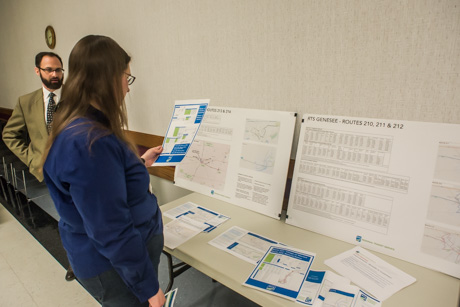Suicide Corners has a reputation, and as the name implies, it's not a good one.
While accidents may not be frequent where East Road crosses Route 20, when they have occurred -- at least until a few years ago -- they've been deadly.
There were fatal accidents at the intersection in June 1998, April 1999 and June 2004. One was a triple fatal and another a double fatal.
After the 2004 accidents, Bethany residents gathered 2,633 signatures asking the NYS Department of Transportation to do something about the intersection.
Their thought -- regrade Route 20.
The state's response: No physical changes to the roadway were necessary. The DOT put up bigger and brighter signs.
There hasn't been a fatal accident at the intersection since, only fender-benders, according to Tom Douglas. He said accidents have been reduced by 36 percent.
Douglas, who with his wife, Debbie, raised six kids in a 200-year-old house (formerly an inn with a second-story dance floor) on property abutting Suicide Corners. He and his son personally witnessed the 2004 accident, which claimed the life of an infant and two other people (inset photo from the memorial on a pole across East Road from the Douglas residence).
Now, seven years after the last fatal accident, DOT officials have apparently decided it's time to take more drastic measures to make the intersection safer.
The proposal: A $1.8 million traffic circle, a roundabout like the one on Oak Street in the City of Batavia.
If the project is approved, Tom and Debbie Douglas will lose their home. The state will seize their property through eminent domain (providing fair market value and relocation expenses).
About a quarter of the traffic circle will be on their current property, with the roadway through the area moving moved southward several dozens of feet.
Tom Douglas said not only will his family lose their home, a home with some local history, he doesn't believe the project serves any useful purpose.
"Statistically," he said, "It's not needed."
Lori Maher, public information officer for the DOT in the Genesee Region, said what the DOT is looking at is the entire history of the intersection, not just the past few years.
"That (no fatalities since 2004) doesn't mean that the problem is corrected and we should walk away from it, so we are pursuing a safety improvement program," Maher said.
But she said that doesn't mean the state will necessarily build a roundabout and that the Douglases will lose their home.
The proper corrective action is still under review and state engineers may yet determine that a roundabout is not the best solution (weighing, in fact, the serious decision of proceeding with eminent domain on the Douglas property).
The project, however, has been funded for construction to begin in the summer of 2013.
There will be public meetings and ample time for the public to provide feedback on the project, Maher said, but because fact-finding is not yet completed, no dates for those hearings have been set.
Douglas, town building inspector (Debbie is town clerk) and Bethany Town Supervisor Louis Gayton also question the wisdom of spending money on a roundabout when the Bethany Town Center Road bridge over Route 20 is in such drastic need of replacement or repair. Chunks of it regularly fall off onto Route 20.
"One of these days, somebody is going to get injured," Douglas said.
The main issue, Douglas said, isn't the traffic on Route 20. It's drivers on East Road, mostly northbound drivers, blowing through the intersection.
Douglas and others have suggested rumble strips on East Road, but both the state and the county highway department have rejected the idea as impractical.
"They think people will just drive around them," Douglas said. "But if they're driving around them, they're slowing down. It would still alert them to the intersection."
Gayton wonders if the roundabout will even improve safety.
"Trucks come through there at 60 to 65 mph," Gayton said. "Now they've got to slow down to 15 mph. I don't need to tell you what will happen."
Tim Hens, the county's highway superintendent, in an email sent Monday to county legislators obtained by Douglas, also questioned the DOT's decision.
This is not set in stone yet as it has to muster a public review process and final board adoption, but if adopted, we stand to lose funding for three bridge projects in the immediate TIP period covering 2011-14. This may only be the tip of the iceberg if new transportation reauthorization is not clear by the end of the year.
I did find it odd that they decided to keep the NEW Rt 20/East Rd (Suicide Corners) roundabout in the plan versus EXISTING bridges that are deteriorating. I know there has been loss of life at this corner, but not sure the roundabout is a popular solution with many local people.
Maher said, however, that the funding sources for bridges are different than the funding sources for intersection improvements. If an improvement -- roundabout or not -- for Suicide Corners isn't approved, then the $1.8 million slated for the project will just go to another intersection in the Genesee Region in need of improvement.
Sheriff Gary Maha, who attended a May 24 meeting with the DOT where the plan was first presented said he will leave the decision about how to improve safety to the experts, but he does know the state is increasingly using roundabouts throughout the state to improve safety on major roadways. He just visited two in Saratoga Springs.
"There's been a lot of serious accidents there over the years," Maha said. "I support anything that could improve safety in the area, certainly."

